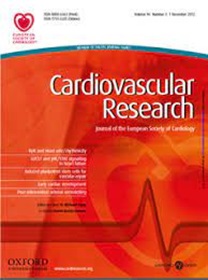一种罕见的肝脂肪酶功能变异通过LDL受体不依赖的机制减轻小鼠的高胆固醇血症和动脉粥样硬化
IF 13.3
1区 医学
Q1 CARDIAC & CARDIOVASCULAR SYSTEMS
引用次数: 0
摘要
目的LIPC编码肝脂肪酶(HL),这是一种肝脏结合蛋白,具有磷脂酶和甘油三酯脂肪酶活性,参与循环脂蛋白的分解代谢。我们最近发现了具有选择性增加磷脂酶活性的功能获得型变异HL-E97G,作为人类家族性合并低胆固醇血症的一个新的遗传原因。HL在动脉粥样硬化发展中的作用仍有争议。在这种情况下,HL-E97G对动脉粥样硬化发展的作用尚不清楚。方法与结果比较HL- e97g与野生型HL (HL- wt)对高胆固醇APOE*3-Leiden的降脂和抗动脉粥样硬化的作用。CETP小鼠是一种成熟的类人脂蛋白代谢模型,并评估这些作用对LDL受体(LDLR -/-)缺陷小鼠(LDLR -/-)途径的依赖性。载脂蛋白e * 3.莱顿。CETP小鼠或Ldlr-/-小鼠静脉注射表达eGFP(对照)、HL-WT或HL-E97G (3×1011 GC/小鼠)的AAV8,同时喂食促动脉粥样硬化饮食。每月测量血浆胆固醇水平,并在终止时评估主动脉粥样硬化病变大小。HL-E97G显著降低APOE*3-Leiden的血浆总胆固醇暴露。CETP小鼠(与对照组相比-63%;-58%(与HL-WT相比),至少部分原因是肝脏对(V)LDL的摄取增加,伴随着动脉粥样硬化病变大小的显着减少(与对照组相比-98%;-97% vs HL-WT)。重要的是,HL-E97G还能显著降低ldl -/-小鼠的血浆胆固醇暴露(与对照组相比降低80%;-77%(与HL-WT相比),主动脉根部动脉粥样硬化病变大小减小(与对照组相比-54%;-41%(与HL-WT相比)和主动脉弓(与对照组相比-73%;-70% vs HL-WT)。结论:HL-E97G通过增加(V)LDL的摄取来降低血浆胆固醇水平,从而减少小鼠动脉粥样硬化的发展,而不依赖于LDLR途径。这些数据表明,调节HL功能是治疗家族性高胆固醇血症患者的一种很有前景的工具。本文章由计算机程序翻译,如有差异,请以英文原文为准。
A rare gain of function variant of hepatic lipase attenuates hypercholesterolemia and atherosclerosis in mice via an LDL receptor-independent mechanism
Aims LIPC encodes hepatic lipase (HL), a liver-bound protein with both phospholipase and triglyceride lipase activity, and involved in the catabolism of circulating lipoproteins. We recently identified the gain-of-function variant HL-E97G, with selectively increased phospholipase activity, as a new genetic cause of familial combined hypocholesterolemia in humans. The role of HL in the development of atherosclerosis remains controversial. In this context, the action of HL-E97G on the development of atherosclerosis remains unknown. Methods and Results To evaluate the lipid-lowering and anti-atherogenic properties of HL-E97G versus wild-type HL (HL-WT) in hypercholesterolemic APOE*3-Leiden.CETP mice, a well-established model for human-like lipoprotein metabolism, and to assess dependence of these effects on the LDL receptor (LDLR) pathway in LDLR-deficient (Ldlr-/-) mice. APOE*3.Leiden.CETP mice or Ldlr-/- mice received an intravenous injection of AAV8 expressing either eGFP (control), HL-WT or HL-E97G (3×1011 GC/mouse) while being fed pro-atherogenic diets. Plasma cholesterol levels were measured monthly, and aortic atherosclerotic lesion sizes were assessed at termination. HL-E97G largely decreased plasma total cholesterol exposure in APOE*3-Leiden.CETP mice (-63% vs control; -58% vs HL-WT), resulting at least in part from increased uptake of (V)LDL by the liver, accompanied by a marked decrease in atherosclerotic lesion size (-98% vs control; -97% vs HL-WT) in the aortic root. Importantly, HL-E97G also strongly reduced plasma cholesterol exposure in Ldlr-/- mice (-80% vs control; -77% vs HL-WT), and decreased atherosclerotic lesion size in the aortic root (-54% vs control; -41% vs HL-WT) and the aortic arch (-73% vs control; -70% vs HL-WT). Conclusions HL-E97G strongly reduces plasma cholesterol levels, by increasing the uptake of (V)LDL, to decrease atherosclerosis development in mice independently of the LDLR pathway. These data suggest that modulating HL function is a promising tool in patients with familial hypercholesterolemia.
求助全文
通过发布文献求助,成功后即可免费获取论文全文。
去求助
来源期刊

Cardiovascular Research
医学-心血管系统
CiteScore
21.50
自引率
3.70%
发文量
547
审稿时长
1 months
期刊介绍:
Cardiovascular Research
Journal Overview:
International journal of the European Society of Cardiology
Focuses on basic and translational research in cardiology and cardiovascular biology
Aims to enhance insight into cardiovascular disease mechanisms and innovation prospects
Submission Criteria:
Welcomes papers covering molecular, sub-cellular, cellular, organ, and organism levels
Accepts clinical proof-of-concept and translational studies
Manuscripts expected to provide significant contribution to cardiovascular biology and diseases
 求助内容:
求助内容: 应助结果提醒方式:
应助结果提醒方式:


